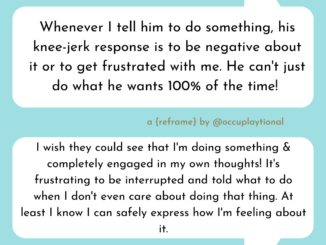People use the word “redirect” to mean a lot of things.
Sometimes people are using it to talk about actions. Sometimes they are using it to talk about emotions. Sometimes they are using it to talk about energy levels.
Sometimes people are using it to talk about distracting. Sometimes they are using it to actually talk about re-directing.
People could use it in sentences like these:
“When he starts hitting his sibling I try to redirect him…”
“She was crying so I redirected her to her favorite blocks…”
“Our class is trying to walk down the hallway and she needs to be redirected to stand in line over and over again…”
“Whenever he screams I try to redirect him but it doesn’t work…”
“He was so full of silly overwhelmed feelings that he was pushing things over and I was worried he might hurt himself so I redirected him into roughhousing with me…”
And all of those sentences mean a slightly different thing!
Here’s the thing about distracting as a technique. Sometimes distractions can be helpful. If I need to have blood drawn, I will need to hardcore distract myself to cope through that situation. In a much more everyday and much less high-stakes situation, I often distract myself while I get out of bed and go get dressed for the morning when it’s cold, because I don’t like being undressed in the cold air. I will often open my phone and read something I find interesting, and I can go through the motions of putting my clothes on without that activity needing my full attention. This is not redirection. This is distraction. It is its own coping mechanism and it is sometimes very helpful and appropriate, especially when it comes to actions, not emotions.
Distracting is sometimes used with small children especially, in relation to their emotions. Older children and adults will even use it on themselves in relation to their emotions. This can occasionally be helpful for a short burst of time. For example, if I’m driving the car and I’m hit by a wave of grief about a terrible thing that has happened recently, I might need to distract myself with music, a podcast, or a phone call with a friend in order to safely get to wherever I am. The time for processing that emotion might not be that very second. (Or I might need to pull over and wait, or ask for help another way.)
When it’s not helpful is when it’s used chronically. If I refuse to deal with my grief by resorting to coping mechanisms that distract me every minute of every day so i don’t think about it, I’m not making myself a healthier person.
Neither is it making a child a healthier person when they start crying about something and an adult quickly swoops in to wiggle a toy in front of their face, start talking fast and loud about some other subject, or hand them a screen.
I mentioned earlier that I use a screen to cope with the sensory processing aspect of getting dressed on cold mornings. I am not saying that screens are never helpful nor am I demonising them. (I’ve written in the past about screen and technology use more extensively — that’s not intended to be the point of this whole post so I’ll try to keep it to just this paragraph.) Especially in relation to sensory processing in the world, many neurodivergent people — diagnosed or not — instinctually use screens to distract themselves or lower their amount of sensory overwhelm while completing tasks that they must complete for purposes of being able to get through life. This is an intentional coping mechanism and can be a useful one.
Human beings don’t have to experience every single part of life at the most sensorily or grounded-ly intense possible aspect of every single little thing. You can eat food and be distracted thinking about something else—you don’t have to live 100% in the moment every single second of every single crumb you ever eat. But you might enjoy your food more often, and have a more connected relationship with the way food feels inside your body, if you eat sometimes without other distractions.
All of this is subject to the fact that sometimes prioritisation is important. Sometimes a family is working really hard on their relationship with food and one another, and so they focus on just that and let the specifics of bedtime go. Or vice versa. Or any one of a million other things I could mention.
What I most often see with little kids is that adults take advantage of the fact that they have a short attention span in order to try to snap them quickly out of feeling however they were feeling about a particular thing. The adult feels like they were successful because now the kid is engaged in playing with something else and “forgot” about being upset about xyz. Then, if the kid has a meltdown later that seems disproportional to the precursor, or even seems like it was “completely out of nowhere”…the adult doesn’t put the two events together. But one might absolutely have influenced the other. Those emotions had to go somewhere, and just because they got squished down for a bit doesn’t mean that they were taken care of.
Conversely, people sometimes use “redirect” to mean that they’re expressing a wish or a poorly-held boundary that some action not happen. They might say “He tried to hit his sibling so I redirected him” and what they mean is that they said “hands are not for hitting” and maybe blocked the child for awhile and then expected that whole process to become internalised.
But when you’re holding a boundary with your kid, it is because you have decided that the boundary is important for the sake of itself. The not-hitting is important so that the other child doesn’t get hit, and you are blocking it for the sake of making that happen, not so that you teach the hitter a lesson. The hitter *will* pick up on it over time, when they have the maturity and the impulse control, and until then, you *are* their maturity and their impulse control.
I try to never redirect emotions. The only “redirecting” that I do is trying to take an action and apply it in a new way, to a safer way that action can take place. For example, I would work with a team and a child to redirect the child’s chewing on unsafe/unsanitary non-food objects into chewing on a safe chewing substitute. The action is staying the same. The substitute is staying as close to the original as possible. The child is allowed to feel however they feel. We are just taking the action and making it safer.
Sometimes sensory/emotional energy can be redirected that way, too. If I’m feeling angry and furious and need to rip and tear things, somebody putting cardboard in my hand for me to rip can be very helpful. They are not stopping me from feeling the emotion or dangling a toy in front of me to distract me. They are helping me channel it.
When you re-direct a stream, the water keeps flowing in the same direction—you don’t dam it up. When you re-direct a page online, you send the person to a new, similar, relevant page to what they needed—you don’t just shut down their computer program. It is the same thing with re-directing a child.



